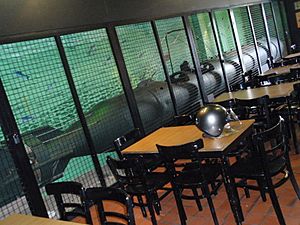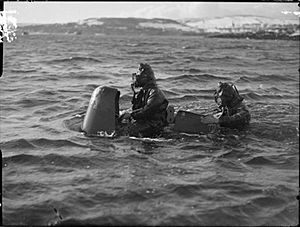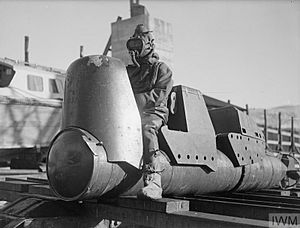Chariot manned torpedo facts for kids
The Chariot was a special underwater vehicle used by the British Navy during World War II. It was like a small, manned torpedo. The idea for the Chariot came from brave Italian naval commandos. In 1941, these commandos used their own "manned torpedoes" called Maiali. They rode them into the port of Alexandria and attached bombs to enemy ships. This caused a lot of damage to big battleships like HMS Valiant and HMS Queen Elizabeth. The British wanted their own version to do similar secret missions.
Contents
History of the Chariot
Work on the Chariot began in April 1942. Two Royal Navy officers, Commander Geoffrey Sladen and Lieutenant Commander William Richmond "Tiny" Fell, led the project.
Crews were trained at different secret locations. They started at HMS Titania in Gosport. Later, training moved to remote lochs in Scotland. These places included Loch Erisort, Loch a' Choire, and Loch Cairnbawn. Another training ship, HMS Bonaventure, was also used in the same area.

How the Chariot Worked
Chariot Models
Two main types of Chariots were built:
- Chariot Mark I
The Mark I was made starting in 1942. It was about 6.8 meters (22 feet) long. It could go about 4.6 kilometers per hour (2.5 knots). This model weighed 1.6 tonnes and could dive up to 27 meters (88 feet) deep. Its motor had three speed settings. It could travel for about seven to eight hours on its battery. The front part, called the warhead, held 272 kilograms (600 pounds) of powerful explosives. A total of 34 Mark I Chariots were made.
- Chariot Mark II
The Mark II was produced from early 1944. It was longer, about 9.3 meters (30 feet) long. It weighed about 2,359 kilograms (5,200 pounds). This model was faster, reaching about 8.3 kilometers per hour (4.5 knots). It could travel for five to six hours at full speed. The Mark II had two riders who sat back-to-back inside an enclosed area. Its warhead carried 544 kilograms (1,200 pounds) of explosives, which was twice as much as the Mark I. Thirty Mark II Chariots were built.
You can easily tell the Mark II apart from the Mark I. In the Mark II, the crew sat almost completely inside the hull, with only their heads sticking out. Both types of Chariots were built by Stothert & Pitt, a company in Bath, Somerset.
Getting to the Target
Chariots could not travel very far on their own. So, they had to be carried close to their target first. A submarine would usually carry the Chariot. The Chariot's warhead, which was a bomb with a timer, would be detached and left on the enemy ship. After placing the bomb, the crew would try to ride the Chariot back to their submarine. Sometimes, they had to leave the Chariot and escape in other ways.
The first attempt to use Chariots was called Operation Title. In October 1942, two Chariots were taken to Norway on a fishing boat. The goal was to attack the German battleship Tirpitz. But bad weather caused both Chariots to break loose and get lost.
Later, submarines carried the Chariots. At first, special tubes were built on the submarine's deck to hold the Chariots. Ten such tubes were made in total. Later in the war, Chariots were simply tied down to the submarine's deck.
Chariot Successes
British Chariot operations were not always as successful as the Italian ones. However, despite some equipment problems and bad luck, there were some important victories.
Operation Principle: Attacks in Italy
On January 3, 1943, Chariots launched from the submarines HMS Thunderbolt and HMS Trooper. They attacked ships in Palermo harbor, Italy. They sank the Italian cruiser Ulpio Traiano and badly damaged the troop ship Viminale.
Six Chariot crew members were captured, and two died. Only one Chariot and its crew were recovered. Rod Dove received a special medal, the DSO, for his bravery in this raid.
At the same time, another submarine, P311, was supposed to attack targets at La Maddalena. This submarine never returned and was thought to have hit a mine.
Operation Husky: Beach Reconnaissance
Chariots were not just used for attacks. In May and June 1943, they helped with Operation Husky. This was the Allied invasion of Sicily. Chariots were used to check out the beaches where troops would land. Submarines HMS Unseen and HMS Unrivalled deployed the Chariots for this important scouting mission.
Operation QWZ: Sinking the Bolzano
On June 2, 1944, British and Italian forces worked together. They wanted to stop the German military from using the Italian cruisers Bolzano and Gorizia at La Spezia. One Chariot had a leak and had to be abandoned. But the other Chariot reached the Bolzano. With help from Italian frogmen, they successfully sank the Bolzano.
Ceylon Secret Operation 51: Phuket Harbour
The most successful British Chariot operation happened on October 28–29, 1944. Two crews on Mark II Chariots, led by Lieutenant Tony Eldridge, were launched from the submarine HMS Trenchant. They sank two ships in the harbor of Japanese-occupied Phuket, Thailand.
See also
- British commando frogmen
- Neger



